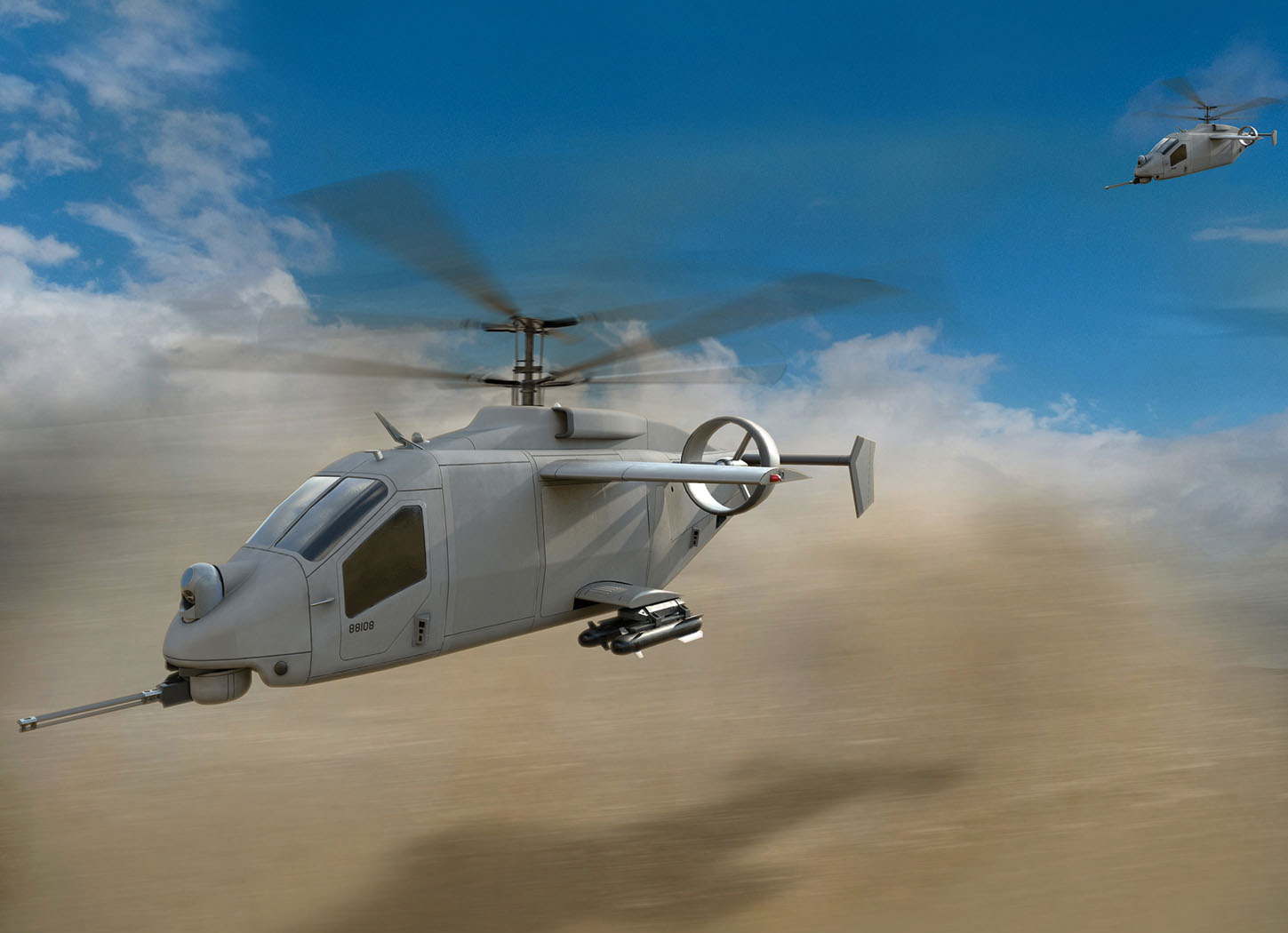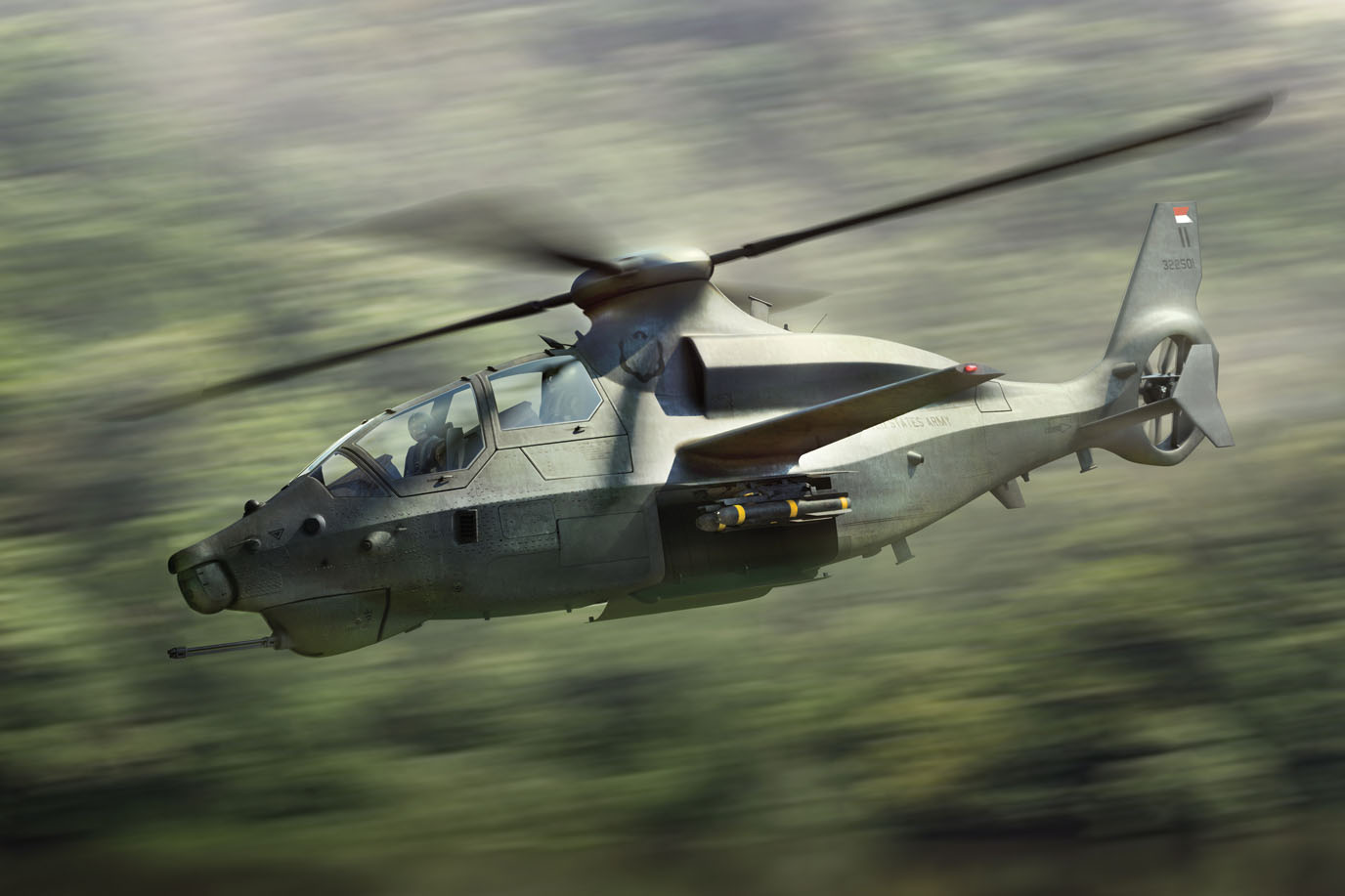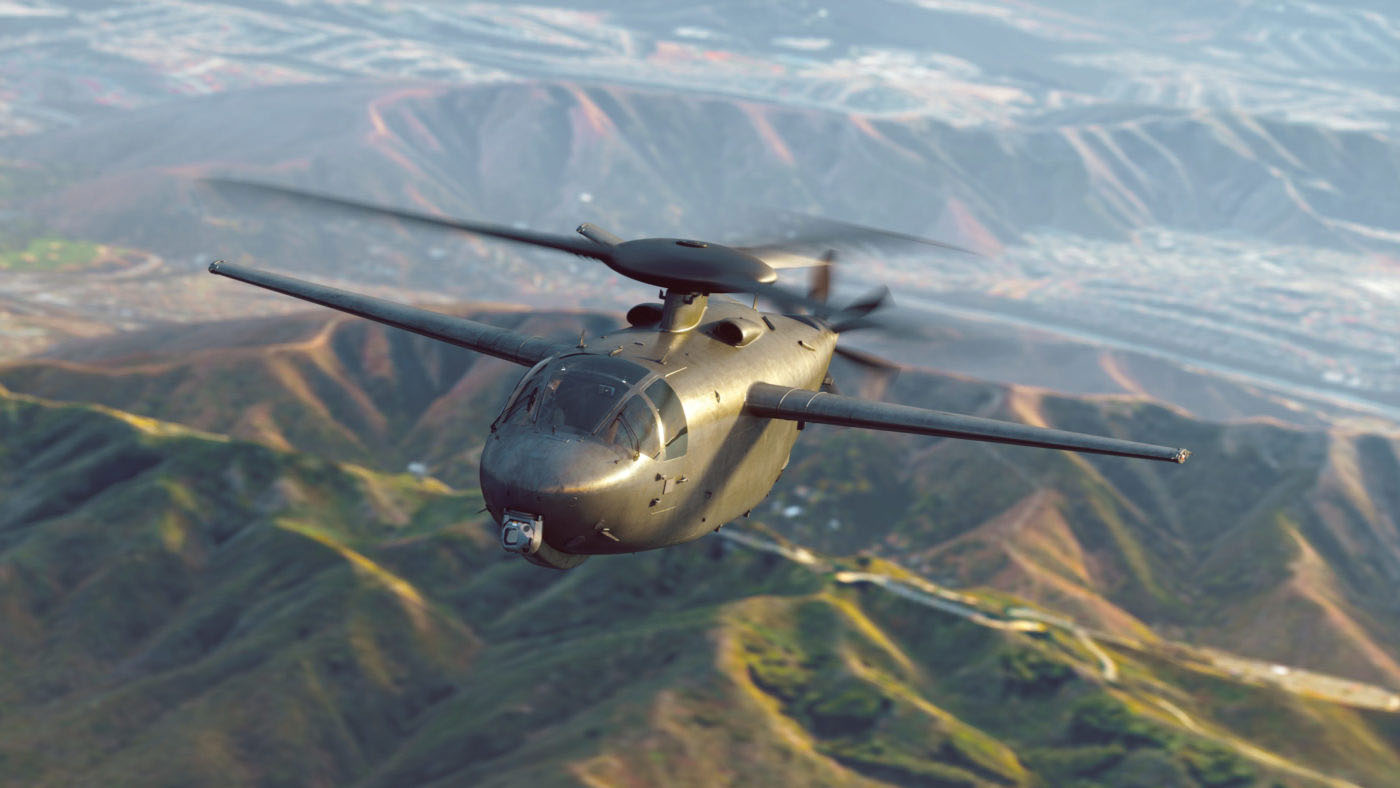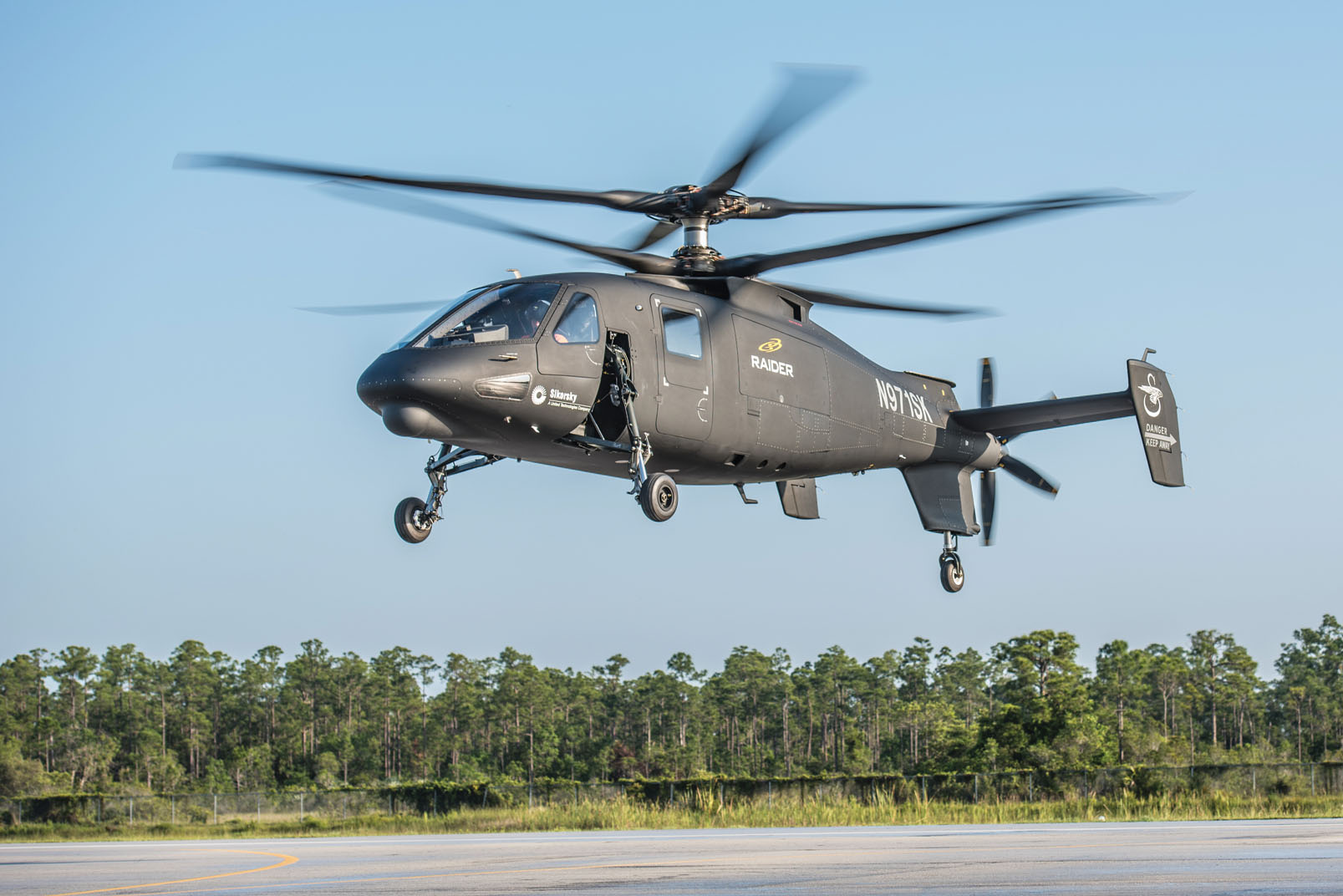FVL Program Aims For Overwhelming Advancement of Aircraft Survivability Capability – JED, April 2020
– By John Haystead –
The US Army has identified aircraft survivability as the single most important factor driving the design and development of its next-generation family of Future Vertical Lift (FVL) rotorcraft. In that context, however, the Army views survivability in holistic terms to include platform detectability, maneuverability, standoff range, multi-platform integration, smart weapons, etc. – with on-board electronic protection systems, or aircraft survivability equipment (ASE) providing the final element of protection. BG Walter Rugen, Director of the Army’s FVL Cross-Functional Team (CFT), summed up the role of ASE at the Army Aviation Association of America (AAAA) ASE Symposium last November. “If everything else fails, ASE will blunt them at their end game and we will still survive.”
The FVL initiative is actually a joint-Service DOD effort led by the Army but including the Navy/Marine Corps and Special Operations Command (SOCOM). The goal is to provide future forces with capabilities that dramatically overmatch enemy air defense systems by, as General Rugen describes – “disintegrating their area access/aerial denial (A2/AD) layers and structures.”
CAPABILITY SETS
The overall FVL aircraft development effort is generally organized around five different “capability sets” (CapSets). As explained by COL Matthew Isaacson, FVL CFT Chief of Operations, the CapSet structure and designations were created to serve as an initial structure for the FVL development plan, but as the program has progressed, their individual focus has somewhat evolved as the Army and the other Services are now moving to meet more of their Service-specific requirements.
As it stands today, CapSet 1 is composed of the development of an optionally-manned, light scout aircraft – Future Attack Reconnaissance Aircraft (FARA), together with the development of future unmanned air systems (FUAS). In April 2019, the Army awarded five industry contracts to develop competitive prototypes for the FARA. The competitors are AVX Aircraft teamed with L3Harris Technologies; Bell Textron; Boeing; Karem Aircraft teamed with Northrop Grumman and Raytheon; and Sikorsky. At the time of this article writing, the Army plan was to down-select to two players in March to be followed by final design and competitive prototypes for flight test and evaluation in 2023. Low-rate production would then begin in 2028 with Operational Test and Evaluation (OT&E) throughout the 2028-2030 timeframe.
The use of advanced UAS, or Air-Launched Effects (ALEs), will be a critical element of the FVL mission capabilities. Individual or heterogeneous swarms of ALEs fitted with electronic warfare support and electronic attack payloads will be deployed to assist in the penetration and defeat of enemy A2/AD environments. The CapSet 1 FUAS effort incorporates both armed and unarmed ALE vehicles small enough to launch from the FARA and Future Long Range Assault Aircraft (FLRAA) platforms, as well as a ground-launched Future Tactical Unmanned Aircraft System (FTUAS) intended to replace the RQ-7 Shadow UAS.
Four companies are competing in the program with field testing into 2021 – Arcturus UAV; L3Harris; Textron; and Martin UAV. According to Vincent Baglio, Director of Business Development for EW, L3Harris, Space & Airborne Systems (East Palm Bay, FL), the ALE mix will include both kinetic and EW payloads operating over various ranges. “The idea is to penetrate the area, disintegrate an adversary’s integrated air defenses and allow the manned platforms to push ahead.” L3Harris has a small form factor EW payload that they have previously flight tested on UAVs and are looking to leverage for the ALE portion of the FVL program.
CapSet 3 covers the Future Long Range Assault Aircraft (FLRAA) or squad carrier. In addition to replacing Army/Navy-Marine Corp Black Hawk/Apache/Seahawk/Venom aircraft, possible plans for the FLRAA had called for it to replace SOCOM MH-60M Black Hawk helicopters. The Marine Corps had also been looking at replacing their UH-1Y utility and AH-1Z attack helicopters with the FLRAA, but may now be looking at a much-lighter platform better suited to small-deck ships that would be a spinoff of FARA. This would be known as the CapSet 2 Attack Utility Replacement Aircraft (AURA). Colonel Isaacson points out that the Army has completed an Analysis of Alternatives (AoA) for the FLRAA that includes all of the multi-Service interests. “It’s all a bit pre-decisional at this point, however, since we don’t yet have a design selection to one airframe.”
Originally, Bell Textron and Sikorsky-Boeing had built Joint Multi-Role Technology Demonstrators (JMR-TDs) to model the FLRAA, however the FARA effort subsequently outpaced and now overlaps development and production of that platform, although the Army says it is looking at expedited decision cycles and contracting processes to align the FLRAA with FARA.
According to an RFI released in April of last year, the schedule for FLRAA had called for a contract award in the fourth quarter of FY2021, first prototype flight in the 3rd quarter of FY2024, a Weapon System Critical Design Review in the 4th quarter of FY2024, and a first-unit-equipped target in the 2nd quarter of FY2030, however, as referenced by Colonel Isaacson, the FLRAA is managed by PEO Aviation, which is currently in a Competitive Development and Risk Reduction (CDRR) and selection phase with the program. As a result, these dates and milestones may be revised.
CapSets 4 and 5 are intended to address future potential heavy air assault missions as well as other heavy-lift requirements such as MEDEVAC, Amphibious Assault, Humanitarian Assistance, etc. But, as pointed out by Colonel Isaacson, these are not currently within the ongoing program’s purview, as the Army’s interest is limited to CapSets 1-3. “Any Army interest in CapSets 4 and 5 would be something in the future.” As described by General Rugen, plans to replace the heavy-lift, Block II enhanced, CH-47F Chinook with CapSet 5 have been placed on indefinite hold. “For the foreseeable future, the modernized Chinook will exploit maneuver windows in enemy defenses opened by FARA, FLRAA and joint forces.”
MATCHING ASE TO THE THREAT
Tracking advanced ASE development and integration with the FVL aircraft development schedule, as well as meeting, and in fact out-pacing, the threat is obviously challenging. And, although it is still relatively early in the development process, expectations are that the next-generation ASE suite supporting FVL aircraft will, by demand, offer major advancements over existing capabilities.
James Conroy, Northrop Grumman Vice President, Navigation, Targeting & Survivability (Rolling Meadows, IL) says, “There’s no doubt that the threats are getting more complex, and by virtue of this, so too are survivability systems – especially as the threats become multi-spectral. This will require a holistic approach to detecting, avoiding and defeating them. We must also remember that the aircrew is the primary survivability system, and solutions should be focused on enabling the crew to make informed decisions in order to provide the aircrew with a fused pre-declarative understanding of the electronic order of battle. Mission functions, such as targeting, route planning and degraded visual environment operations, can all benefit from a properly integrated aircraft survivability suite.”
Dave Harrold, Vice President and General Manager, Countermeasure and Electromagnetic Attack Solutions, BAE Systems Electronic Systems Sector (Nashua, NH), also emphasizes this point. “We recognize that FVL will be required to operate in a contested and congested EM environment for extended periods and under austere conditions. As the threats rapidly evolve, the next generation ASE suite is going to have to provide multi-spectral detection and response across RF, IR, and EO portions of the spectrum. You really need to be moving toward a threat-agnostic type of environment. As a result, these detection and response capabilities can no longer operate independently as stand-alone systems.”
One challenge, observes L3Harris’s Baglio, will be balancing the requirements of the concept of operations (CONOPs) and determining how to best design a system-of-systems with both offboard assets such as ALEs and onboard capabilities for self-protection. “This is a tradeoff question that will require a lot of simulation, a lot of force-level type simulation, and a lot of information regarding capabilities.”
Colonel Isaacson defines the Army’s view of the requirement in the following terms. “What we see in the requirements arena of Multi-Domain Operations is the need to have a ‘shorter human-decision cycle’ – to be able to react, decide, and do everything that military units do, and communicate in a more timely manner.” Referencing the 2018 National Defense Strategy (NDS), which has played a large role in driving today’s emerging concepts of MDO and discussion of Joint All-Domain Operations, Colonel Isaacson says that “while each Service has their own interpretation of how this goes, the consistent approach is the need to communicate over, and decide and share information from system to system over, a resilient, self-healing mesh network across the Joint Services – the Joint All-Domain Command and Control (JADCC) network. With FVL, it’s not ASE alone. It’s the ability to complement and share with other aircraft capabilities including Degraded Visual Environment, artificial intelligence (AI), and Assisted Target Recognition, among others. And, it’s also about sharing across platforms, so if I sense something on my aircraft, sharing that with others across a mesh network.”
COL Kevin Chaney, ASE Project Manager (PM –ASE) within the Army’s Program Executive Office for Intelligence Electronic Warfare and Sensors (PEO IEW&S) fully agrees. Noting that his preference is to discuss the requirement in terms of detect and defeat, Chaney says, “On the detection side, Colonel Isaacson hit it squarely on the head with sensor fusion – the ability to take inputs from different sensors and fuse those together to obtain a holistic picture of the battlefield. This is one of the key elements that we’re pursuing going forward.”
Another emphasis area related to accomplishing shorter human-decision time cycles, says Colonel Chaney, is the development and implementation of AI and automation to provide autonomy and cognitive-offloading within the manned FVL cockpits. “One of the challenges we have right now is the cycle time from detecting a threat to developing a countermeasure solution and pushing that out to the field. We need to get to the point where, when we see something that maybe we haven’t previously seen, but has similar characteristics to something that we have seen, that we will still be able to declare on it.”
Colonel Chaney points to his shop’s Limited Interim Missile Warning System (LIMWS) program as an example of ongoing efforts aimed at maturing and implementing AI. “I think we’re on a path with LIMWS that already has some level of machine-learning capability, getting us away from the look-up tables and able to make determinations based on identifying threat characteristics, particularly if it passes off to a laser-based jammer which is essentially free ammunition to see if we can defeat it. Obviously, it’s not to the higher levels that we ultimately want to reach, but we’re at least progressing on a path to mature this technology as we go forward.”
Also with FVL, Colonel Chaney says they’re looking at shortening decision time cycles for flight systems overall. “We’re looking at going to ‘supervised full autonomy’ as we go forward – combining all the sensor data that you can get and allowing it to help make decisions on routes to and from that will help us be more survivable in the future.”
Specific to the “defeat side” of Chaney’s view of the requirement, he says that ultimately the goal is to provide hard-kill, as well as soft-kill, options to defeat threats. “It may be still years away, but we have to be able to defeat everything coming at us – not in the same sense as small-arms fire, but of a major projectile. We need to figure out a way to knock it off course or just completely destroy it.”
MOSA
Conformance to the Modular Open Systems Architecture (MOSA) has been clearly identified as a pre-requisite to participating in the FVL ASE solution, and all of the FVL platforms, including Future Unmanned Air Systems (FUAS) will be built upon the architecture. MOSA is intended to both speed new capabilities to the fleet and eliminate vendor-specific, proprietary software and hardware.
MOSA is being modeled in a three-phase Mission System Architecture Demonstration (MSAD) which runs through December 2020. According to General Rugen, two mission systems architecture capstone demonstrations using government-defined standards and interfaces have already been well-received by industry. Collins Aerospace, Boeing and Raytheon have been named mission system integrators for the third-phase capstone program being managed by the Army Combat Capabilities Development Command (CCDC) Aviation & Missile Center (Huntsville, AL). As explained by Colonel Isaacson, “We’re looking to continue to mature the architecture, so that we can incorporate that knowledge in the requirement, and not end up asking too much from an OEM. This is why we have a foundational requirements document just to standardize what MOSA is within the Army, and although this does not yet have final approval, we do have a great deal of consensus.”
All of the potential industry participants in the FVL program recognize the critical importance of MOSA in realizing the desired technology and capability goals of the platform. Says BAE’s Harrold, “The degree of integration we’re looking at of multi-modal sensors, enhancing situational awareness, multi-function capabilities, and the high accuracy of detection and response capability needed, is really a significant change to the existing architectures of ASE capabilities out there. In addition, given how rapidly these threat changes happen, integration really has to be approached in such a way as to retain both the modularity and the openness at those key interfaces in the architecture to really enable rapid upgrades that can keep pace. With MOSA, we can get where we want to go collectively to really enable future increments of new capabilities on the platforms and not have to try to jam as many requirements in before the official acquisition process milestone.”
From his point of view, Harrold says he prefers to use the word “approach,” rather than “architecture” in the MOSA acronym. “Often when we say MOSA, and use the word architecture, it really constrains the problem for people. So, I prefer the use of the word ‘approach,’ because it opens the aperture about what’s in the art of the possible. Our view is that it’s really a business and technology strategy that delivers an open architecture but that the architecture itself has to be defined for the specific application. The Army has established several working groups that define system architectures, and like others we’re participating in those groups to help the community come to a consensus on what it needs to look like for FVL.”
Northrop Grumman’s Conroy observes that the progression of multi-functionality is similar to the innovative use of sensors and software on commercial smart devices, to include an open framework that allows verified third party content to add capabilities as they are required. Architecting for “the progressive integration of the individual survivability realms (IR, RF, EO) is a complex undertaking, and the fusion of real-time data from each part of the survivability suite requires a ‘first-do-no-harm’ approach that preserves the timelines so critical to a survivability system’s effectiveness.” Conroy emphasizes that “an important part of that foundation is the warfighter perspective and feedback on how to make the user experience for multifunctional systems as intuitive as possible, ensuring that the operational benefits of integration are optimized for the end user.”
Conroy adds, “We’ve proven that we can do multi-spectral as well as multi-functional, the real question is how to advance the architecture by applying customer-defined MOSA principles while preserving those timelines. Doing so ensures that ASE solutions effectively go beyond their current federated state and become greater than the sum of their parts. This will decrease the time it takes to respond to threats and increase platform capabilities through multi-functional approaches.”
SWAP
Closely related to the importance of MOSA is the need for everything intended for FVL platforms to be super compliant to size, weight and power (SWaP) constraints and desires. In that regard, Colonel Chaney says that, “Because SWaP is such a huge concern for us, the more we can combine without degrading performance will help us in the future. As such, multi-spectral sensors that can look across different EMS bands will be extremely beneficial, and we’re also looking at ways to get more fiber-optics onto the aircraft and into the systems.”
In fact, as pointed out by NG’s Conroy, the greater challenge will be in providing for increased capabilities while also reducing SWaP. “Systems will have to ‘buy’ their way onto the Mission Equipment package (MEP) by bringing the aforementioned multi-functionality with them. This will require that both requirements and acquisition strategies account for more than one discipline in their processes.”
BAE’s Harrold agrees, noting that, “There’s a trade space across everything that you want to put on the platform, requiring not only getting away from federated, stand-alone systems, but creating greater capability within smaller packaging and form factors.”
L3Harris’s Baglio adds that “SWaP also relates to the power and location of processing aboard the platforms. The more processing power that can be put into a single processor, even though it may itself be relatively large with multiple drop-in cards for different functionality such as comms, jamming, ESM, etc., will certainly provide SWaP benefits overall.”
Chaney says the Army is indeed working to take advantage of advancements in microelectronics technology to reduce the number of black boxes on the aircraft, and potentially host them in something like the Aviation Mission Computer System (AMCS) being developed by PEO Aviation. “It will be essentially like a server in the sky, where I can insert a couple of cards in place of what used to be in multiple black boxes, and potentially provide a huge size and weight saving measure.”
REQUIREMENTS DETERMINATION AND LINES-OF-EFFORT
In terms of the Army’s overall, all-encompassing approach to the FVL survivability requirement, the Service is organized around a number of critical “lines-of-effort (signature efforts)” and “enabling tenets.” The four lines-of-effort are CapSet 1 – FARA and FTUAS; CapSet 3 – FLRAA; MOSA; and ALEs. The four enabling tenets are: lethality, survivability, affordability and reach, and according to Colonel Isaacson, “Survivability is one of the signature tenets across all the other lines of effort and tenets and, we have survivability requirements defined across all of them.” So far, the Army has approved “appropriate-level requirements documents” for FARA, FLRAA, and for ALEs, and a requirements document is in staffing for MOSA.
FARA is the most forward line-of-effort, with the Army gaining approval in the summer of 2018 for an “initial capability refinement document.” This turned into a solicitation managed by the Aviation and Missile Center of CCDC, and which is now in a competitive-prototype and source-selection phase. As described by Colonel Isaacson, the approach provided more flexibility in terms of the survivability requirements. “We left the requirements document appropriately vague for where we are in the timeline. Since we’re fielding in just less than ten years, it would be premature to set exact requirements, and industry had the opportunity to earn their way onto the OEM’s platform.”
Colonel Isaacson says that although they’ve seen a great deal of technology maturation, “there’s also a great deal more out there in industry that has not been precluded from being brought to the table. It’s not specifically all in the category of ASE, but in terms of affording industry the opportunity to bring a sensor-fusion solution to the table that capitalizes on sharing data, sharing capability, and reducing the SWaP burden and loss of utility on the platform.”
Isaacson, says the Army is not yet at the same place with the FLRAA ASE, where they want to make firm requirements decisions. “We’ve been through one turn of an abbreviated capability development document, and we did mention ASE within that, but we’re not at a point where we necessarily need to make those decisions on requirements yet.”
Colonel Chaney agrees. “We’re basically looking at allowing the OEMs to show us anything that we’re not already apprised of, but is embedded within the platform requirements. We’re just watching and seeing what the vendors are proposing.”
There is also an open question as to the pathway by which the FVL ASE capabilities will ultimately be acquired, with the Army potentially having the airframe manufacturers providing only the platforms themselves and the various aircraft systems provided as government-furnished equipment (GFE). Chaney agrees that these decisions have not yet been made. “We’re looking at all available options and are preserving our decision space on this going forward. We want to see if there are any options out there that we haven’t seen previously, and we’re trying to make sure that we understand everything that all of the OEMs have their hands on, and then try to come up with the best solutions and approaches for each of the platforms.”
The real answer to the question of where ASE currently stands in the timeline of the FVL acquisition process requires looking at the entire process, from R&D through fielding. Says Colonel Isaacson, “In the S&T arena, what we’re doing now is slightly different than before. We’re taking what the engineers have done, discovered and studied, and we’re iterating this through prototyping, and not just through prototyping, but taking those prototypes to the next level and putting them in relevant operational environments with current technology. All along the way, we’re incorporating soldier input.”
As an illustration of how the process works, Colonel Isaacson points to a technology demonstration exercise called “Project Convergence” and a new phrase the Army is coining known as “MOSA for A3I,” standing for modular open system approach for architecture, autonomy, automation, and interface. Says Isaacson, “What we’ve been lacking in the past is a clear understanding of what MOSA is actually for, but through Project Convergence and MOSA for A3I, we’re able to provide an opportunity to cut across not just Army aviation but across the other branches of the Army and the emerging technologies from the other CFTs that represent them, to get after that same architecture.” The approach allows us to capitalize on shared lethality and shared survivability concerns, or things that inform, between other commanders and operators on the battlefield. Because of MOSA for A3I, we’ll be a whole lot less clunky in the future, a whole lot more enabled, and have an ability to rapidly upgrade at a more affordable cost and therefore increase our chances of success against peer and near-peer adversaries.
As described by Colonel Chaney, “The MOSA for A3I and Project Convergence is a new paradigm of development and acquisition streamlining – bringing in capability faster than previously done. Although he says there are “obviously some challenges with bringing in a new capability this way, and it will still have to go through a lot of the ‘-ilities’ testing,” he concludes that “once we’ve demonstrated it and determined it’s filling a capability gap that we need filled, it will be a faster way to bring a new capability to the fleet. It also provides a path that OEMs can use if they have a truly unique capability that they’ve been working on to bring it to the fight.”
“When technology is successfully demonstrated in this manner,” says Colonel Isaacson, “it’s the easiest way for those technologies to find their way into one of our requirements documents. The benefit is that we’re not inventing as much new technology as we used to in a requirements document. We’re elevating the standard by which requirements subsets get into that document.” ♦
If you enjoyed this article, please share. If you would like to read more articles like this one, we encourage you to join the AOC to receive a copy of JED every month.




